Remote detonator that saved London and the American fleet
The Anglo-Saxon allies in World War II actively collaborated in the development and production of new and existing technologies to support military operations and gather intelligence.
Several technologies invented in Great Britain turned out to be critical for the armed forces and were widely used by the Americans during World War II (no one was going to share precisely such technologies with the Soviet Union).
Military historians in the first place among all such innovations and technologies put the invention and use of proximity fuses.
Topicality
The relevance of developing a practical artillery fuse, which would not depend on time calculations to the target, or even on physical contact with the target, was obvious to anyone familiar with the limitations of traditional anti-aircraft artillery.
The gunners of the time recognized that shooting down a small, fast-moving, high-flying plane was mostly luck. Periodic research has shown that, statistically, a direct hit can occur with only one of the approximately 1 anti-aircraft shells fired.
"They're good for harassing enemy aircraft at night, but that's about it."
BACKGROUND
Prior to the invention of the proximity fuse, detonation was caused by direct contact, a timer set at startup, or an altimeter.
All of these early methods used were flawed.
• The probability of direct hitting a small moving target is low; a projectile that misses the target will not explode.
• A fuse that is triggered by time or altitude requires a good forecast by the gunner and accurate timing on the fuse. If something is wrong, then even with correct aiming, the projectiles can “uselessly” explode before reaching the target or after passing it.
Air defenses using timer fuses had to fire many shots in order to shoot down something.
The proximity fuse is devoid of these disadvantages., a projectile or rocket only needs to fly past the target at a fairly short distance.
Regardless of the sensor used, the preset sensing distance is calculated so that the explosion occurs close enough to the target that it is either destroyed or seriously damaged.
In the period leading up to World War II, the chances of anti-aircraft guns hitting the target were slim. The calculations required to calculate the intersection of the trajectory of the projectile and the target were so complex that, on average, tens of thousands of projectiles had to be fired to hit the target.
This problem was especially aggravated during the American-Japanese confrontation after Pearl Harbor. In its initial period, the Japanese aviation proved to be more effective than the naval air defense systems of the American fleet.
History
Aichi D3A was the first Japanese aircraft to bomb American targets in the war, beginning at Pearl Harbor, and American bases in the Philippines. They sank more Allied warships than any other Axis aircraft.
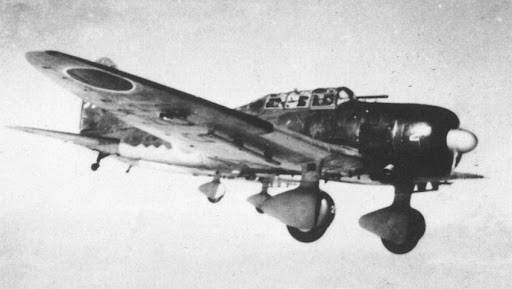
During 1942, dive bombing D3A1 и D3A2 contributed significantly to the sinking of three aircraft carriers in the US Navy: Lexington in the battle for the Coral Sea, Yorktown at the Battle of Midway and Hornet at the Battle of the Santa Cruz Islands.
They also damaged the aircraft carrier. Enterprise both the Battle of the Eastern Solomon Islands and the Battle of the Santa Cruz Islands.
During the war, D3A dive bombers often combined their attacks on enemy warships with a torpedo bomber. IJN Nakajima B5N Kate; therefore, enemy ships were often sunk by a combination of bombs and torpedoes.
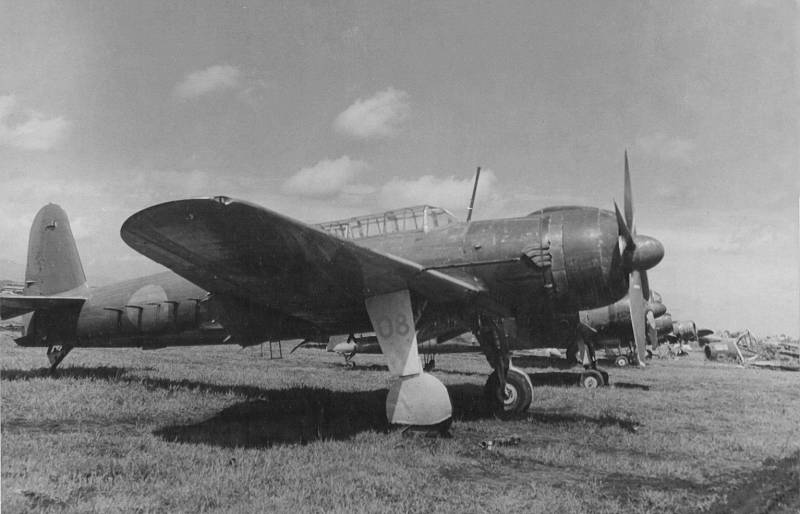
The Nakajima B5n Kate was the standard carrier-based torpedo bomber from the Imperial Japanese Navy for most of World War II.
However, there have been cases where only D3A have made attacks, or at least delivered strikes, leading to the sinking of enemy ships.
The Japanese air advantage ended in early 1943.
On the morning of January 5, 1943, four Japanese Aichi D3A dive bombers caught a US Navy task force operating off Guadalcanal by surprise.
One of them hit the New Zealand light cruiser Achilles before the group interrupted the attack.
With a delay, the Americans began to respond and almost fired in pursuit of enemy aircraft.
USS Helena, one of the first three ships to receive the new remote fuse, fired at a dive bomber heading towards its task force.
The cruiser fired two shots, from one of them the enemy plane caught fire and fell into the water.
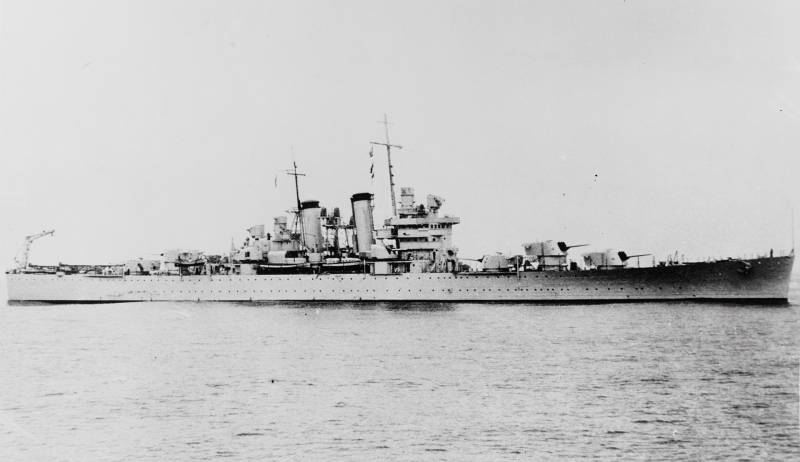
USS Helena (CL-50) - Brooklyn class light cruiser built for the United States Navy in the late 1930s, the ninth and last member of its class.
Although this fight did not attract public attention at the time, it was a watershed moment in stories artillery and air combat - for the first time an enemy aircraft was deliberately shot down by a remote charge.
Later, also at the beginning of 1943, during the campaign in the Solomon Islands, the proximity fuze showed all its advantages when the task forces of Admiral William Halsey were subjected to repeated night attacks by Mitsubishi G4M torpedo bombers (allied name "Betty").
“The smoking fuselages and burning debris on the ground testified to the accuracy of the anti-aircraft batteries and the effectiveness top-secret projectile fuse Mark-32, which passed one of the first combat tests here ”.
In 1943 alone, according to the Air Defense Command, more than half of all Japanese aircraft were shot down as a result of shelling from ships, although only 25 percent of the shells fired were equipped with non-contact fuses - VT.
Scientific groundwork
British scientists began work on the proximity fuse in the late 1930s and solved many of its inherent problems. But their efforts were blocked by cost overruns and the problem of miniature components, especially suitable for mass production.
When the war was on the doorstep, they shared their best practices with the Americans.
American contribution
Founded in the summer of 1940, the US National Defense Research Committee (NDRC) served as the link between the National Academy of Sciences and the Pentagon. The chairman of the committee was the distinguished electrical engineer and inventor, educated at the Massachusetts Institute of Technology, Vannevar Bush.
To solve countless scientific military problems, the committee turned to various specialized departments.
One such unit was Section-T, which was tasked with creating a workable proximity fuse for large-caliber artillery.
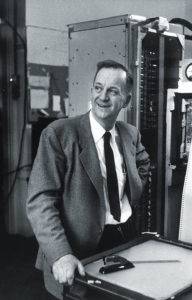
In August 1940 years the section came under the direction of Merle Tuva, an accomplished and innovative physicist at the Carnegie Institution in Washington.
The new research center, called the Applied Physics Laboratory (APL), was established under the auspices of Johns Hopkins University.
The main military customer of his research was the navy.
While trying to develop a workable fuse, Section-T scientists, engineers and ammunition experts faced a number of challenges:
• Creation of an optical, magnetic or electronic feedback mechanism that would signal the "explosion" of an artillery projectile moving at an initial speed of 2 fps as it approaches an enemy aircraft traveling at 600 mph.
• Placement of the radar device (transmitter and receiver) in a 5 "projectile only 20¾" long and already packed with 7 pounds of explosive.
• Shrinking such an electronic device to the size of a milk bottle in an era when no one could imagine transistors or integrated circuits.
• Development of a power source of sufficient power and strength for the operation of the fuse and operation in the temperature range from 100 to minus 50 degrees.
• Development of a fuse capable of withstanding the impact of a 5-inch cannon - acceleration 20 times the force of gravity - as well as the centrifugal force of a rotating projectile at 000 revolutions per second.
• Providing a safety function to ensure safe handling and prevent accidental detonation.
• Manufacturing of universal fuses suitable for use in a number of US and British weapons.
• Development of technology for fast, high quality mass production - in millions of units, with components sourced from many American factories.
Nevertheless, it turned out that the solutions to the problems did not go beyond the capabilities of American scientists, engineers, inventors, technicians, ammunition experts and manufacturers.
They really did it!
But how was it made small enough?
At that time, there was no "solid state" electronic circuit. The radios used convex glass vacuum tubes. Although miniature vacuum tubes were used in hearing aids, they were in no way suitable for use in artillery shells.
The development of miniature glass vacuum tubes capable of withstanding shots became a top priority for physicist James Van Allen. It took nearly a year of research, experimentation and field testing using a series of powerful weapons and explosives.
Meanwhile, APL researchers were refining a transceiver circuit originally developed by British scientists, and National Carbon Co. developed a workable power supply. In the summer and fall of 1941, the refinement of other electronic components and devices continued.
The wartime urgency felt by those working on the fuse project was sharply expressed in a series of prescriptions posted on the walls of Tove's laboratory by the serious and highly motivated Chief of Section T:
The detonator, ultimately developed by Section-T and its partners, used a miniature radio transmitter and a receiver with an amplifier.
It included a thyratron trigger, a gas-filled tube that acts like an electronic switch. It also used a battery operated safety device to prevent accidental explosion.
As the projectile flew, the transmitter sent out a continuous radio signal that bounced off a moving target - similar to how radar does.
The receiver recorded a return signal, the intensity of which increased as the projectile approached the target. As soon as the signal level exceeded a certain threshold, it activated the thyratron trigger, releasing the electrical charge accumulated in the capacitor.
This charge triggered an electric detonator, which in turn set off the main explosive.
Due to the high velocity of the projectile relative to the target, the signal reflected from the target has a frequency offset.
This frequency-shifted signal is fed to a mixer, at the output of which a difference frequency is extracted by a filter. The amplitude of the difference frequency depends on the range to the target.
It's one thing to make a miniature Doppler radar out of vacuum tubes, quite another to make the device work after firing a cannon!
The Applied Physics Laboratory at Johns Hopkins University managed to create a revolutionary fuse that changed the balance of power in America's favor.
By the end of the war, an army of workers had assembled and installed more than 22 million innovative fuses of this type., (each containing about 130 miniature electronic parts), totaling over $ 1 billion in 1940s dollars (roughly $ 15 billion today).
The program remained a closely guarded secret throughout the war, so the Japanese and Germans exposed to such fire never understood why the Allied artillery suddenly became so ultra-precise and deadly.
Fuze production lines have opened at several sites.
One of the first tests of the configuration of tiny electronic components and dry cell batteries occurred on January 29, 1942, when researchers mounted them in 5-inch rounds and fired a standard anti-aircraft gun.
Fifty-two percent of the fuses fired were successful.
This success rate was high enough for the Navy's Arms Directorate to commission Crosley Corp. from Cincinnati, Ohio, to begin pilot production of the fuse. To obscure the significance of the device, the bureau implicitly named it a time-controlled fuse - VT.
The following month, National Carbon developed an improved wet cell battery. The size and shape provided greater stability and longer shelf life by separating the electrolyte liquid in a glass ampoule.
A muzzle blast discharge could break glass and release electrolyte, which, under the action of the centrifugal force of a rotating projectile, would pour out onto the stacked carbon and zinc plates, thus activating the battery - an ingenious solution.
Researchers have worked tirelessly to improve the fuse. To ensure defeat, it had to detonate the moment the target was within the effective 60-meter explosion of a standard 5-inch anti-aircraft projectile.
Test
By the summer of 1942 Tove and his team were ready to test the VT fuse in simulated combat conditions. 12 August newly commissioned light cruiser USS Cleveland, who then sailed in the Chesapeake Bay, began a planned two-day assessment of the new detonator with live fire.
The goals were three drone (small aircraft with radio remote control) - all of them were shot down by gunners on the first day with only four bursts of air defense with proximity fuses, despite evasive maneuvers by the controllers.
Development engineers continued to adapt fuses for use in various calibers of American and British anti-aircraft guns, as well as other naval weapons.
This solved several problems.
Ships were now less likely to run out of anti-aircraft ammunition on long voyages, and they were much better able to defend themselves against coordinated bombing attacks.
Fuses were also modified for installation in aerial bombs and field artillery guns.
Modifications
In practice, this meant producing eight different fuses for the US Navy, 12 for the US Army, four for the Royal Navy, and six for the British Army.
As the proximity fuse has proven itself in combat, the demand for it has grown.
In the end, there were about 70 versions of the device in production, which required constant testing, modifications and changes on the assembly line.
Secrecy
Advanced top-secret fuses were sent to the front line with strict instructions to use them only when the enemy could not find unexploded ordnance.
The United States and Great Britain went to great lengths to ensure that not a single sample fell into the hands of the enemy, and at the same time the Soviet allies. To this end, the device was initially limited to naval use, mainly to ensure that enemy forces could not retrieve unexploded ordnance for examination and replication for use against allies.
Performance
In 1943, more than half of all Japanese aircraft were shot down by anti-aircraft missile systems from VT.
The use of the new fuse in the 5-inch anti-aircraft guns of the Navy expanded throughout the Pacific in the last two years of the war.
Although proximity fuses were available for many applications, the land embargo continued until the summer of 1944, when Germany began bombing London using V-1 flying bombs.
Not targeting specific targets, the rocket missiles have claimed tens of thousands of civilian lives and extensive damage. Launched across the English Channel and approaching 400 mph, the unmanned missiles were difficult to spot and even more difficult to hit.
Defense of England
Section-T began modifying proximity fuses to target small, fast V-1s.
Special fuses were installed in British 3,7-inch anti-aircraft ammunition and US 90-mm anti-aircraft shells.
In mid-July, the Allies deployed about 500 guns to installations along the canal, where their fire posed no danger to RAF fighters. The results have been impressive over the last four weeks of the 80-day campaign.
Application in the troops
In 1944, these shells were finally cleared for ground warfare, and their greatest moment came during the Battle of Bulge, when General George S. Patton ordered them to be used against the congestion tank crews and infantry.
The shells were to explode about 50 feet above the ground. Shrapnel pierced people and light equipment and disabled entire armored and infantry units due to the huge number of wounded and killed soldiers.
In ground combat, projectiles with proximity fuses inflicted terrible damage to people and vehicles.
The proximity fuse has demonstrated its value in two significant military campaigns during the final phase of the war in Europe.
Fight for Antwerp
The Allied battle for control of Antwerp in late 1944 highlighted the key role of the Belgian port in securing a land offensive against Germany.
The devices were put into production at the Crosley plant, and British Prime Minister Winston Churchill authorized a dedicated Lancaster flight to transport fuses from Cincinnati to Antwerp.
Since this largely prevented air attacks, the large supply port remained open throughout the war.
Battle of the Ardennes
16 декабря 1944 года Germany launched its last major offensive on the Western Front, the Battle of the Ardennes.
By then, proximity fuses had been developed and tested for all calibers of American artillery, and large stocks of ammunition had been sent to the European Theater of War.
The embargo on the use of non-contact fused ground munitions, for both anti-aircraft and field artillery, was lifted within two days of the initial attacks, which included the last concentrated air attacks by the Luftwaffe.
The effect was immediate and overwhelming. Since the time the Allies did not cross the Rhine into Germany, more than 1 enemy aircraft were shot down by Allied air defenses.
Moreover, the parallel development of fire control radars allowed gunners to destroy invisible targets on the reverse hillsides and under the canopy, day and night.
Since the artillery was at a high speed, the German soldiers could not hear the shells until they exploded overhead. The trenches did not provide protection, and the shrapnel even pierced the bunkers reinforced with logs.
In fairness, it should be recalled that the assessments of the forces involved in the Battle of the Ardennes and the losses of the parties vary depending on the sources. The Americans tended to exaggerate the strength and losses of the Germans, and the Germans tended to exaggerate the Americans.
The same applies to assessing the role of remote fuses in this final battle.
Conclusion
Materials were declassified in 1995-1997 Operation Venona. This is how the American intelligence services called the systematic collection and decryption of intercepted radio communications between the Soviet intelligence station in the United States and Moscow from 1943 to 1945.
Operation Venona began in 1943 and lasted almost 40 years. The documents of "Venona", in particular, testify that the American radio engineer Julius Rosenberg, who was later executed with his wife on charges of espionage for the USSR, actually worked for Soviet intelligence, and he was doing this solely for ideological reasons.
Most often, Rosenberg's name is mentioned in connection with the American and Soviet atomic programs. However, the information transmitted by him was by no means exhausted by atomic secrets.
It is known that in December 1944, he obtained and handed over to the Soviet intelligence officer Alexander Feklisov detailed documentation and a sample of a finished radar fuse.
Soviet experts highly appreciated this product. At their request, a Resolution of the Council of Ministers of the USSR was adopted on the creation of a special design bureau for the further development of this device and on the establishment of its production.
On July 1945, 9390, the State Defense Committee of the USSR adopted Resolution No. XNUMX on the creation of a Commission for German Radar Products. AI Shokin, the future minister of electronic industry of the USSR, was appointed the head of the group of engineering, technical and scientific workers. The commission was engaged in the collection of samples of devices and products, technical documentation, the study of industrial enterprises, the search and involvement of German specialists in the work.
At the end of 1945, the military plant No. 58 (formerly Shot Foundry - Moscow) of the People's Commissariat of Ammunition, together with its special design bureau, was reoriented by the decision of the USSR Government to the serial production of radio equipment for mass ammunition, primarily radar fuses for anti-aircraft shells and bombs.
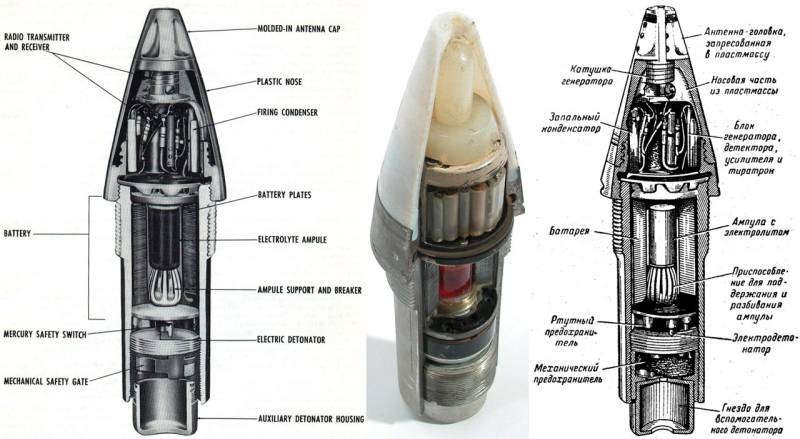
On the left and in the center is the American Mark 32 radio fuse, and on the right is the Soviet AR-30
As a result, a few years later, the production of exact copies of American VTs was established in the USSR under the designation AR. These fuses in several modifications were produced until the 1960s, adding to the long list of weapons and military equipment obtained by the Soviet Union through military-industrial espionage and copying of foreign designs.
Subscribe to our Telegram channel, daily additional materials that do not get on the site: https://t.me/topwar_ru
- Sergey Ivanov ([email protected])
- historynet.com, history.navy.mil
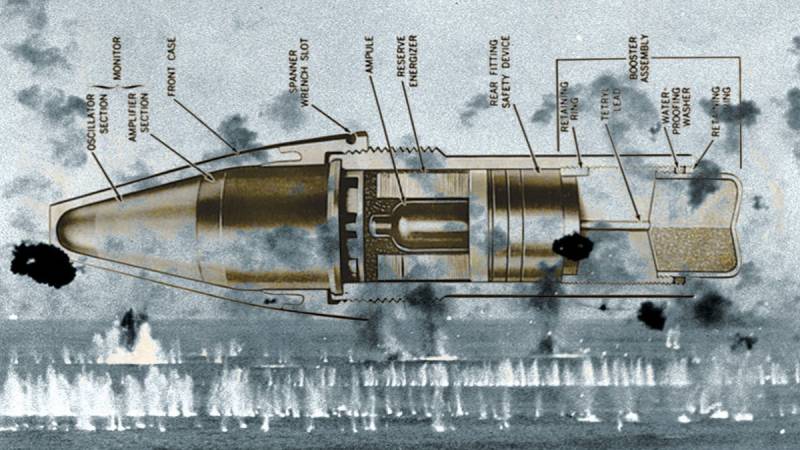
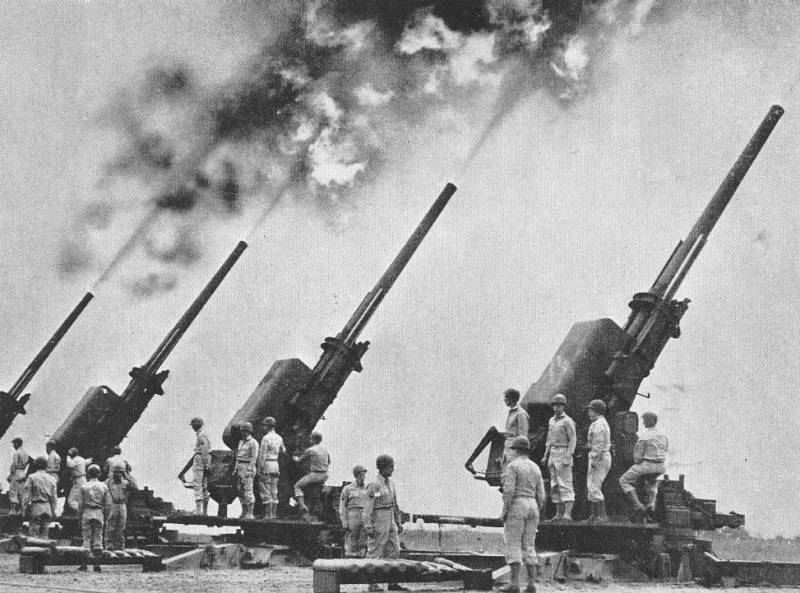
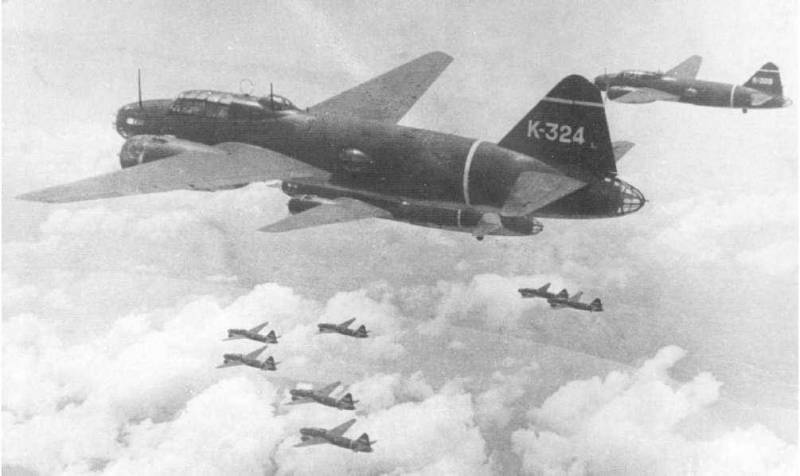
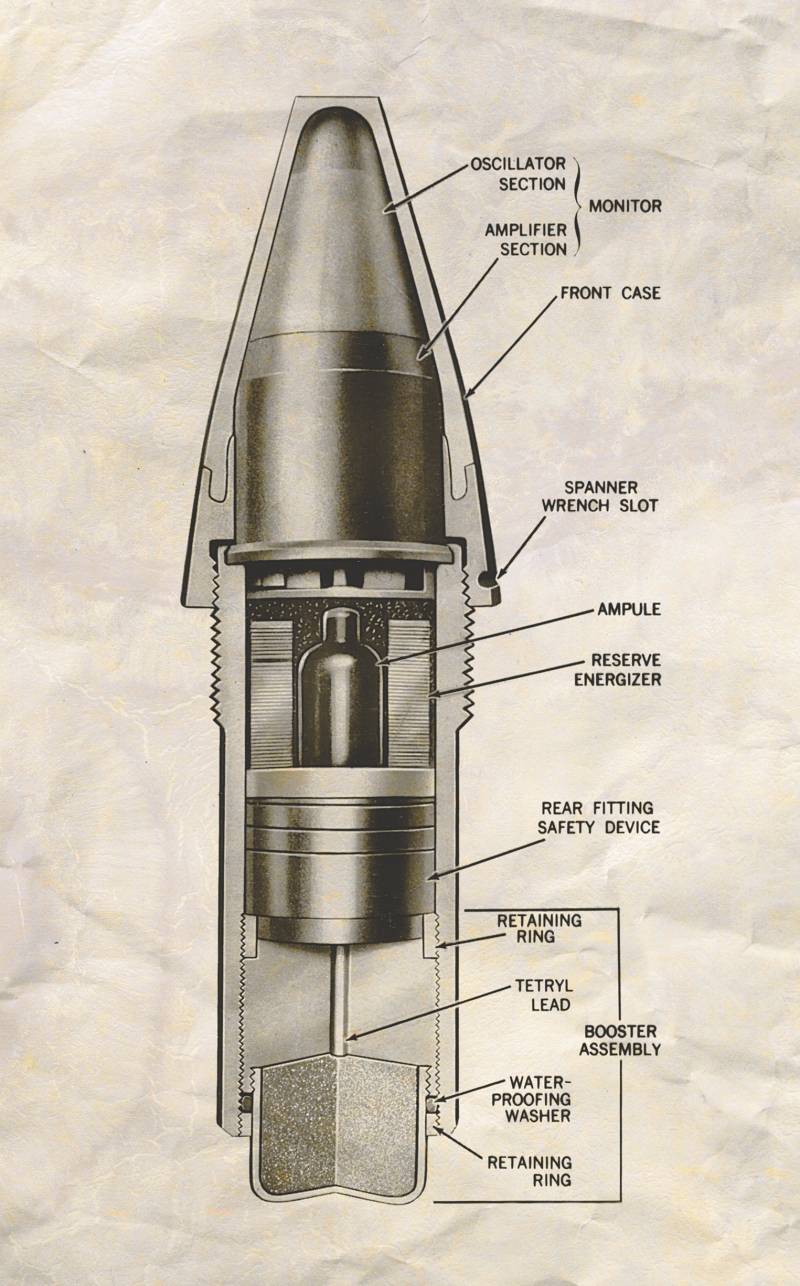
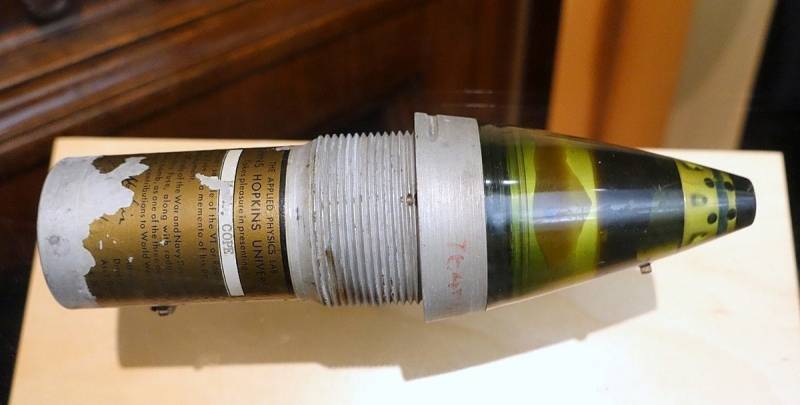
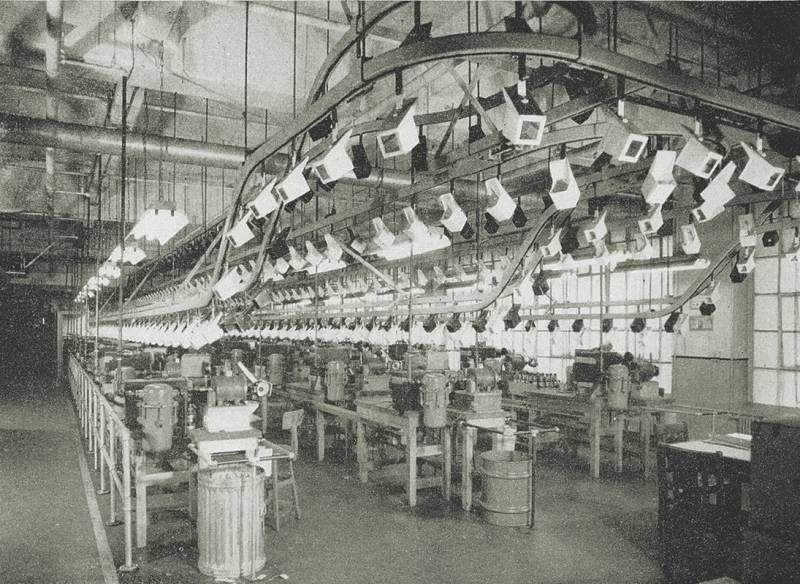
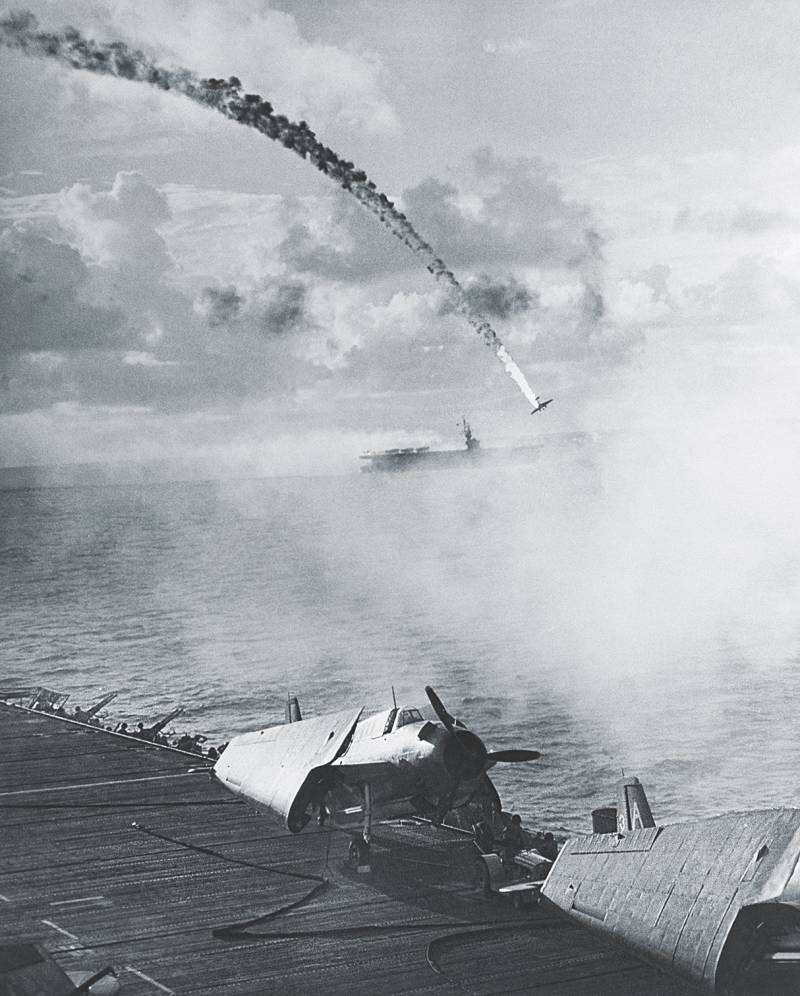
Information